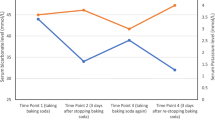Summary
Although alkalosis and renal compromise may occur from the use of antacids and milk, severe disease with features corresponding to those which Burnettet al. described could be found in only 33 cases through 1963. Many more cases of transient changes have been reported, sometimes under the eponym of “Burnett's syndrome.”
Generally, there was a long history of excessive intake of milk and absorbable alkali, mostly sodium bicarbonate. The most common manifestations were anorexia, dry mouth, dizziness, pruritus, polyuria, or other manifestations of renal insufficiency. Azotemia and hypercalcemia were present; the serum phosphorus was normal or elevated, and the alkaline phosphatase was normal. Previous renal disease was present in about one-third of the cases. Urinary calcium excretion was normal. Band keratopathy, nephrocalcinosis, or other metastatic calcification was usually present.
The pathogenesis is obscure. The amount of calcium appeared to be greater than normal. A long history of high milk intake was present in 29 of 32 patients and absorbable alkali (mostly sodium bicarbonate) in all 33 of the patients with Burnett's syndrome. Pre-existing renal disease was present in about one-third of the patients. Other metabolic abnormalities such as potassium depletion may contribute to the renal impairment. The major condition to be considered in differential diagnosis is primary hyperparathyroidism. Improvement on a diet low in calcium and absorbable alkali may be useful in patients without irreversible renal disease. Surgical exploration and examination of the parathyroid tissue may be necessary in some instances. Treatment consists principally of a low calcium diet, a high fluid intake and discontinuance of absorbable alkali.
Similar content being viewed by others
References
Sippy, B. W. Gastric and duodenal ulcer: medical cure by an efficient removal of gastric juice corrosion.J.A.M.A. 64:1625, 1915.
Hardt, L. L., andRivers, A. B. Toxic manifestations following the alkaline treatment of peptic ulcer.Arch. Int. Med. 31:171, 1923.
Cope, C. L. Base changes in the alkalosis produced by the treatment of gastric ulcer with alkalies.Clin. Sc. 2:287, 1936.
Burnett, C. H., Commons, R. R., Albright, F., andHoward, J. E. Hypercalcemia without hypercalcuria or hypophosphatemia, calcinosis and renal insufficiency.New England J. Med. 240:787, 1949.
Forland, M., andPullman, T. N. Electrolyte complications of drug treatment.M. Clin. North America 47:113, 1963.
Wenger, J., Kirsner, J. B., andPalmer, W. L. The milk-alkali syndrome.Gastroenterology 33:745, 1957.
Punsar, S., andSomer, T. The milk-alkali syndrome: a report of three illustrative cases and a review of the literature.Acta med. scandinav. 173:435, 1963.
Henneman, P. H., andBaker, W. H. Two mechanisms of sustained hypercalcemia following hypervitaminosis D and the milk-alkali syndrome (abst.)J. Clin. Invest. 36:899, 1957.
Randall, R. E., Jr., Strauss, M. B., andMcNeely, W. F. The milk-alkali syndrome.Arch. Int. Med. 107:163, 1961.
Henneman, P. H., Dempsey, E. F., Carroll, E. L., andAlbright, F. The cause of hypercalcuria in sarcoid and its treatment with cortisone and sodium phytate.J. Clin. Invest. 35:1229, 1956.
Burnett, C. H., Burrows, B. A., andCommons, R. R. Studies of alkalosis I. Renal function, during and following alkalosis resulting from pyloric obstruction.J. Clin. Invest. 29:169, 1950.
Van Goidsenhoven, G. M.-T., Gray, O. V., Price, A. V., andSanderson, P. H. Effect of prolonged administration of large doses of sodium bicarbonate in man.Clin. Sc. 13:383, 1954.
Schwartz, W. B., andRelman, A. S. Metabolic and renal studies in chronic potassium depletion resulting from overuse of laxatives.J. Clin. Invest. 32:258, 1953.
McGee, L. C, Martin, J. E., Jr., Levy, F., andPurdum, R. B. The influence of alkalis on renal function.Am. J. Digest. Dis. 6:186, 1939.
Kirsner, J. B., andPalmer, W. L. The role of chlorides in alkalosis following the administration of calcium carbonate.J.A.M.A. 116:384, 1941.
Kyle, L. H. Differentiation of hyperparathyroidism and the milk-alkali (Burnett) syndrome.New England J. Med. 251:1035, 1954.
Author information
Authors and Affiliations
Rights and permissions
About this article
Cite this article
Texter, E.C., Laureta, H.C. The milk-alkali syndrome. Digest Dis Sci 11, 413–418 (1966). https://doi.org/10.1007/BF02233637
Issue Date:
DOI: https://doi.org/10.1007/BF02233637




